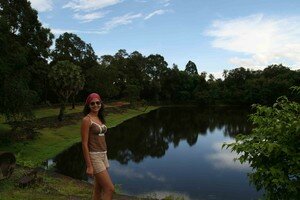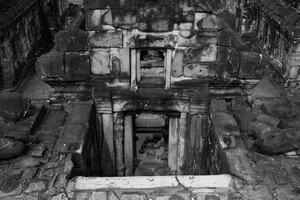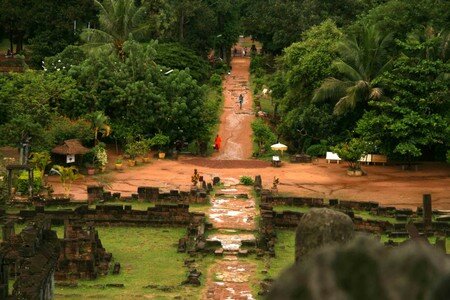Bakong
.
In its pyramidal form Bakong presents itself as having been the main temple of Hariharalaya, where the cult of the god king was practised. Here the idol could be elevated in dignity above the plains bordering the great lake, and here the Khmer royalty came to affirm itself - indeed it is not impossible that the construction of this “temple-mountain” was initiated by Jayavarman II on his descent from the Kulen hills.
Of all the temples on stepped terraces of the Angkor region, Bakong is perhaps the one which most closely responds to the idea of the cosmic Mount Meru on five levels, corresponding, from bottom to top respectively, to the world of the Nagas, the Garudas, the Rakshasas, the Yakshas, and then to the Maharajas of the four cardinal points with their court. In the proportion of its tiers, it is the only pyramid that makes allowance for processions and festivals, and being more human in scale than the usual “stairway to heaven”, it also responds the best to our western principles. Finally it is also the first realisation in sandstone of a large architectural ensemble, a fact indicated by the founder himself - the king Indravarman - who called it “the stone house of Isa”.
Before restoration the temple of Bakong was little more than a mound of earth. Having been the object over the centuries of systematic destruction and subject to various alterations, its sandstone elements had been completely razed and their stones scattered at the base of the pyramid. In particular nothing remained of the central sanctuary - built after the other towers - except for the external outline of its base on the paving of the upper platform. From a pile of rubble it has now reassumed its entire silhouette.
While other restored monuments still stood perhaps ruined but with their crumbled elements lying at their feet, Bakong however presented nothing but chaos, with no clue to the number or nature of the missing buildings. Only by grouping the stones in categories according to their moulding or decoration could one determine their respective positions.
.
DESCRIPTION
The track to the temple penetrates the third enclosure - an area of some 900 metres east-west by 700 north-south formed by a moat that only remains visible in places - leaving to the left, on the north side and close to the north-east corner, a group of three brick towers aligned north-south of which only one still stands. Similar remnants of wall stand just to the south of the main axis, close to the eastern gopura of the second enclosure, - the remains all part of a series of brick buildings, generally badly ruined, that surround the monument.
The second enclosure is defined by a laterite wall that is partially buried and intersected to the east and west by laterite and sandstone gopuras - cruciform in plan but badly ruined - and others to the north and south that are similar in nature but more modest in proportion.
 The moats are crossed, to the east and west, by long paved causeways - their monumental character emphasised by enormous nagas whose bodies rest on the bare ground and whose massive seven headed terminal motifs are quite different to the elegant naga-balustrades on supporting blocks that were to become general in the 12th century.
The moats are crossed, to the east and west, by long paved causeways - their monumental character emphasised by enormous nagas whose bodies rest on the bare ground and whose massive seven headed terminal motifs are quite different to the elegant naga-balustrades on supporting blocks that were to become general in the 12th century.
To either side of the eastern entrance, continued as a pavement lined with standing bornes, one passes successively:
- the remains of two rigorously symmetrical long rooms with large balustered openings, preceded by porticoes and followed by small annexe rooms of slight proportions which were perhaps rest galleries,
- then two buildings in laterite, the southern of which sheltered the temple’s foundation stele,
- and finally two longer buildings all in sandstone but with walls filled with re-used blocks. Certainly late, they give the impression, with their single avant-corps opening to the pavement, of having been utility buildings for use as store-rooms.
The north-east and south-east corners of the enclosure are each occupied by two juxtaposed square brick buildings - nearly intact on the south but crumbling to the springing of the vaults on the north. Open to the west with an aperture sculpted from a monolith of sandstone, they receive daylight only through a pattern of small round holes. The north-west and south-west corners have only one building of the same type, but opening to the east and now completely ruined. Eight sanctuary towers in brick - two on each side - originally coated externally in the sculpted paste of a lime based plaster, are arranged around the pyramid. Of the four to the east of the north-south axis, which dominate those to the west, only the tower on the north side remains standing. The two to the east are, unusually, set on a double sandstone base, moulded and decorated in the style of the monument, with some evidence of a reshaping of the entrance motif - notably to the colonnettes. Square in plan with redents, these towers all open to the east with four axial stairways that form a double flight, embellished with lions squatting at their bases. The only sandstone elements are the frames of the openings with their richly decorated banded cylindrical colonnettes, and the lintels that are particularly high and surmounted with a frieze.  Doors and false doors are uniformly sculpted from a single monolithic block from which the void of the opening is hewn, which explains their reduced proportion with respect to the whole. The ornamentation of the false doors is remarkable, with a mascaron on each panel perhaps recalling the motif of door handles on wooden panels. The lintels, with those of the Kulen style (the first half of the 9th century), are amongst the finest to be found in Khmer art - the rich decoration, enhanced with a multitude of figures in a great variety of detail, is without affectation and remains purely decorative. We especially recommend those on the western towers which remain in a perfect state of preservation. On the corner piers, the dvarapalas and devatas in stucco alternate according to the orientation, sheltered within niches in the form of palatial arcature. Above, the false upper stories reduce only slightly and have become shapeless. They apparently carried miniature sandstone towers at the corners of their cornice, several of which were found during clearing work. Practically abutting the southern part of the enclosure wall stretches the long body of a building in three parts, forming a gallery with a portico that is axial on the eastern towers. Completely demolished, it seems not to have had its twin on the northern side.
Doors and false doors are uniformly sculpted from a single monolithic block from which the void of the opening is hewn, which explains their reduced proportion with respect to the whole. The ornamentation of the false doors is remarkable, with a mascaron on each panel perhaps recalling the motif of door handles on wooden panels. The lintels, with those of the Kulen style (the first half of the 9th century), are amongst the finest to be found in Khmer art - the rich decoration, enhanced with a multitude of figures in a great variety of detail, is without affectation and remains purely decorative. We especially recommend those on the western towers which remain in a perfect state of preservation. On the corner piers, the dvarapalas and devatas in stucco alternate according to the orientation, sheltered within niches in the form of palatial arcature. Above, the false upper stories reduce only slightly and have become shapeless. They apparently carried miniature sandstone towers at the corners of their cornice, several of which were found during clearing work. Practically abutting the southern part of the enclosure wall stretches the long body of a building in three parts, forming a gallery with a portico that is axial on the eastern towers. Completely demolished, it seems not to have had its twin on the northern side.
The five tiered pyramid is almost square and entirely clad and paved in sandstone. The fourth and fifth levels were built on a thick bed of laterite which has not moved, while the three others, founded on earth fill, have settled by some twenty centimetres. The upper level dominates the surrounding ground level by 14 metres and the tiered retaining walls, which are massive and thick-set, have a uniform cladding with a plain moulded base and a crowning band.
The four axial stairways, in five flights, obey, as do the tiers themselves, the principle of proportional reduction that so gives an illusion of perspective. They have at each landing a superb “accolade” formed base step set between the two side walls, which are themselves sculpted with dvarapalas and devatas and embellished with lions. At their base is quite an unusual type of building. Entirely reconstructed on the northern side, it precedes the first flight and forms a redent in the tier for the full height of the retaining wall. Flanked by two large stone blocks that must have carried some monumental statue, and with sculpted gargoyles to take the water flowing down the steps, each was complemented with a reclining Nandin (the sacred bull) on a pedestal, facing the temple. The presence at the four cardinal points of Shiva’s mount is symbolic of the omnipresent power of the god and suggests that the original sanctuary was open to the four axes, like Phnom Bakheng.
 These unusual buildings have their roofs formed in two sandstone slopes made up of horizontal courses, corbelled to form a triangular section that was then crowned with a crested ridge of sandstone finials, this being the natural transition between a covering in tiles and a vaulted stone arch. One can also see here the first realisation in stone of frontons with figures. Facing the sanctuary they crowd the whole surface, framing a small opening with round colonnettes that lights the gable end - quite unusual in Khmer art. The figures fly or are framed in palatial architecture, set apart on a clear background, much like the motifs sculpted in the plaster coating of contemporary or earlier brick tympanums. This sobriety contrasts with the abundant vegetal or figurative ornamentation that prevailed thereafter. The corners of the three lower tiers of the pyramid are marked by monolithic elephants which decrease in size, though they are unfortunately badly ruined. The fourth tier was in turn lined with a dozen small regularly placed sandstone “prasats”, each sheltering a linga - though nothing remained of them but the foundation bases, buried under the rubble. Ten of them were reconstructed, the remainder mostly being incomplete in their superstructure. They date from the time of the pyramid.
These unusual buildings have their roofs formed in two sandstone slopes made up of horizontal courses, corbelled to form a triangular section that was then crowned with a crested ridge of sandstone finials, this being the natural transition between a covering in tiles and a vaulted stone arch. One can also see here the first realisation in stone of frontons with figures. Facing the sanctuary they crowd the whole surface, framing a small opening with round colonnettes that lights the gable end - quite unusual in Khmer art. The figures fly or are framed in palatial architecture, set apart on a clear background, much like the motifs sculpted in the plaster coating of contemporary or earlier brick tympanums. This sobriety contrasts with the abundant vegetal or figurative ornamentation that prevailed thereafter. The corners of the three lower tiers of the pyramid are marked by monolithic elephants which decrease in size, though they are unfortunately badly ruined. The fourth tier was in turn lined with a dozen small regularly placed sandstone “prasats”, each sheltering a linga - though nothing remained of them but the foundation bases, buried under the rubble. Ten of them were reconstructed, the remainder mostly being incomplete in their superstructure. They date from the time of the pyramid.
The fifth level has around its entire perimeter, framed by a finely decorated moulding, a continuous frieze with figures sculpted in bas-relief. The first of its kind in Khmer art, it is sadly in such a state of erosion that one can distinguish only but a few outlines, mostly scenes of battle or of the court. Four or five of the better preserved panels - notably those on the south side - show a group of asuras in combat, and are sufficient to cause considerable regret for the ruin of the whole.
The central sanctuary, contrary to what is found in other pyramid temples, is visible from each level, due to the unusual width of the tiers. In restoration, despite the use of a large number of replacement blocks, it remains true to the original, due to the similarity of the various composite elements of the upper levels. If one studies the ornamentation in detail one finds evidence of a veritable collection of different styles ranging from the art of Prah Ko to that of Angkor Wat or to the start of the Bayon.
Bearing in mind that the sculptors had only Lolei or Bakong itself as previous models, one is therefore justified in drawing the conclusion that the prasat must have been constructed about two centuries later than the rest of the monument, and in any case could not have been earlier than the Baphuon (second half of the 11th century). Some of the devatas with their hair set in tiaras under the miniature towers are, however, inspired by models from the ninth century, while other decoration, like the frontons with decorative scenes - Shiva dancing to the east, the Churning of the Ocean to the south, reclining Vishnu to the west and Lakshmana amongst the monkeys, entwined by the serpents of Indrajit to the north - is in the style of Angkor Wat. Of Indravarman’s previous scheme for the central sanctuary only the base platform remains. Perhaps the king had no time to finish the construction which was then realised by his successors - or perhaps the prasat was demolished and rebuilt... Whatever the reason, the present tower - of a redented square in plan with four vestibules, three of which have false doors - encloses a sanctuary chamber. Fifteen metres in height it has four upper tiers lined with numerous standing stones and a lotus crown.
Among the sculptures of the 9th century found during the course of the excavation, apart from several finely sculpted and simply treated female figures and the separate heads of masculine and feminine divinities, we found several examples of statues with a backing that must have been encased in the brickwork of the towers. Common during this period, they represent a sitting figure with one knee raised and its naked torso clad in jewellery. Finally, on a pedestal in the crumbling brick tower to the north, on the east side, stands a curious group of three statues cut from a single block of stone, but of which only the bodies remain.





/http%3A%2F%2Fstorage.canalblog.com%2F65%2F83%2F88988%2F19477867_o.jpg)
/http%3A%2F%2Fstorage.canalblog.com%2F47%2F35%2F88988%2F19477489_o.jpg)
/http%3A%2F%2Fstorage.canalblog.com%2F44%2F87%2F88988%2F19247205_o.jpg)
/http%3A%2F%2Fstorage.canalblog.com%2F35%2F56%2F88988%2F19247076_o.jpg)
/https%3A%2F%2Fstorage.canalblog.com%2F68%2F13%2F88988%2F131346695_o.jpg)
/https%3A%2F%2Fstorage.canalblog.com%2F46%2F43%2F88988%2F47990981_o.jpg)
/https%3A%2F%2Fstorage.canalblog.com%2F34%2F23%2F88988%2F47957389_o.jpg)
/https%3A%2F%2Fstorage.canalblog.com%2F69%2F48%2F88988%2F47956242_o.jpg)
/https%3A%2F%2Fstorage.canalblog.com%2F71%2F12%2F88988%2F21063019_o.jpg)